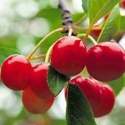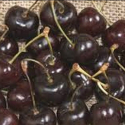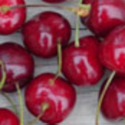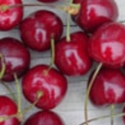Cherry




We have to be honest and say that growing and harvesting Cherries takes a special kind of horticultural hero. It is almost impossible to beat the birds to your delicious crop unless you enclose the tree in some kind of protective covering.
Cherries are hapiest in cool climate areas that have a dry spring and summer. As you can imagine the fruit splits very easily if pelted with heavy rain. Therefore choose your planting position well. It should be a hot and sunny spot, hopefully out of reach of harsh frost and strong wind. The tree itself is not frost tender however heavy frost can damage emerging blossom. Good drainage is essential. Cherries quite like the addition of a little lime if your soil tends to be on the acidic side.
READ MORE
The fruit should mature about 6 weeks after blossom. It is important to keep the tree well watered during this period. The fruit is best picked with the stalks on and consumed as soon as possible after picking - that';s probably not going to present you with a serious problem. The good news is that Cherries are full of "anthocyanins" which are a potent antioxidant. Certainly beats Broccoli in the "good for you" stakes in my opinion.
Cherries don';t need a lot of pruning. There is a definite school of thought that this is better done in summer so the pruning cuts heal quickly and prevent the spread of disease. Cherries can be a little susceptible to bacterial canker and good cultivation methods will certainly help to avoid this but you may have to treat with a spray of Coper Oxychloride every now and then. Let';s hope that with a good horticultural practice (and a little luck) that your life really will be a bowl of cherries!
READ LESS
Find out more at How to Grow Cherries
0 LISTINGS FOR CHERRY
PAGE 1 ALL HL Nurseries Limited t/a Wairere Nursery0 LISTINGS FOR CHERRY
826 Gordonton Road, R D 1, Hamilton 3281 Ph: (07) 824 3430 Email: